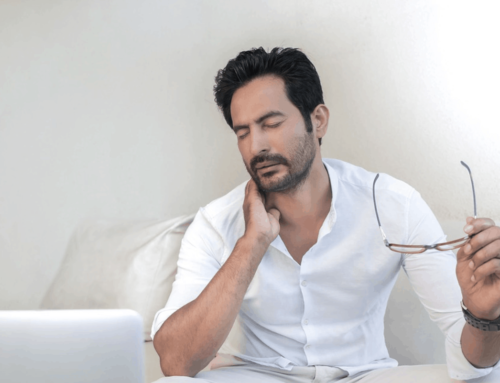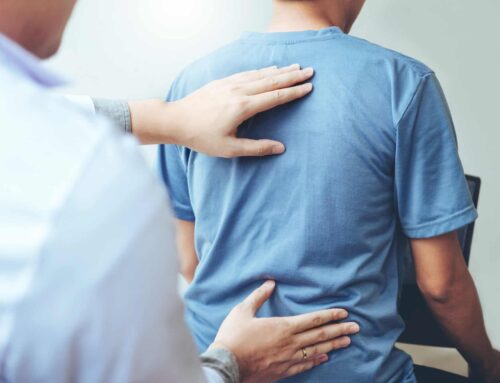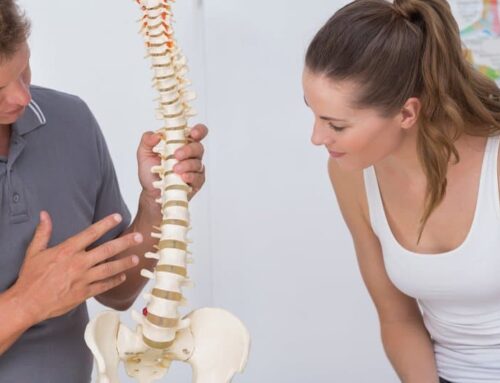Chronic pain, especially chronic back pain, is something one never gets used to. Chronic pain always reminds sufferers of its presence. Things that we all take for granted, like walking, sitting straight, and engaging in sports or exercise often become impossible for chronic pain sufferers. When surgery fails to treat these conditions and fails to provide relief, an interventional procedure called dorsal column stimulator may be what’s needed.
Dealing with Chronic Pain

Pain can be dealt with in many ways. They can be as simple as lifestyle changes, including diet and exercise. These simple adjustments to daily living can work o reduce inflammation or to reduce pain.
Chronic sufferers can also turn to medication such as painkillers or muscle relaxers. While these can offer instant pain relief, they can produce unpleasant effects. This includes a gradual buildup of tolerance to the drugs, and the possibility of addiction. Left unaddressed, these issues often end up as bigger problems than the ones they address.
Surgery or interventional pain management is also a possible solution. Surgery often allows medical professionals to focus directly on problem areas. As with any other medical/health condition, remember that self-diagnosis is often counterproductive and can only make a diagnosis by qualified medical professionals more difficult. If you are considering seeking medical treatment or help with your pain management, let MidSouth Pain Treatment Center’s staff of professional medical staff assist you and suggest the best possible treatment program.
Sometimes, Surgery Isn’t Enough

Surgery to treat back pain sometimes falls short. This leads to a condition called Failed Back Surgery Syndrome. According to the National Institute of Health, low back pain (LBP) happens to an estimated 60% to 80% of the global population at one point or another, with 10% suffering chronic pain. Due to the large number of individuals suffering from this, more and more people turn to surgery.
Even under the best conditions, FBSS happens. This is a term that describes the “surgical end-stage after one or several interventions on the lumbar neuroaxis indicated to relieve low back pain, radicular pain or the combination of both, without effect.” In other words, surgery fails to help relieve the pain. In cases like these, chronic sufferers will need alternative therapy to address their condition.
Dorsal Column Stimulator (DCS)

With surgery out of the question, what options do chronic sufferers have to alleviate their pain?
MidSouth Pain Treatment Center suggests considering an interventional procedure such as a spinal cord stimulator. The procedure is minimally invasive compared to spine surgery and often results in diminishing pain for chronic sufferers. The next section will talk specifically about dorsal column stimulators.
A dorsal column stimulator, also known as a spinal cord stimulator, uses an implantable neuromodulation device that sends electrical signals to targeted areas of the spinal cord (dorsal columns) to treat pain. DCS is a popular option for patients that have not responded to more conventional therapies such as surgery or pain medications.
Is a Dorsal Column Stimulator the Same as a Spinal Cord Stimulator?

The short answer is Yes. Dorsal Column Stimulator is the same as Spinal Cord Stimulator. The dorsal columns refer to the specific areas of the spinal cord containing ascending sensory pathways. These are the pathways that carry painful signals to the brain.
For this article, we will be using Dorsal Column Stimulator (DCS) more frequently. But, we will sometimes interchange the term with the more common term Spinal Cord Stimulator (SCS). In cases like this, be assured that they refer to the same treatment.
Other conditions that can benefit from DCS

Apart from FBSS, there are other medical conditions that can benefit from alternative pain management treatments. These include the following:
- Post-surgical pain. Similar to FBSS, post-surgical pain is chronic pain that occurs after surgery. The pain experienced is different in quality and location from the pain reported that necessitated surgery in the first place. It is a result of an unintended surgical injury, or more commonly, scar tissue upon a major peripheral nerve.
- Arachnoiditis. Arachnoiditis is a painful inflammation of the arachnoid, a thin membrane that covers the brain and spinal cord.
- Angina. Angina, or pain in the chest due to the heart muscle not getting enough oxygen from blood. Angina usually means pressure in the chest, which can radiate into the shoulders, arms, neck, jaw, or back.
- Spinal cord injuries. Any damage to the spinal cord can bring chronic and sometimes intolerable pain.
- Nerve-related pain. These include conditions that cause damage to nerves such as severe diabetic neuropathy, or cancer-related neuropathy caused by radiation, surgery, or chemotherapy.
- Peripheral vascular disease. Peripheral vascular disease (PVD) is a slow and progressive condition that affects the circulation of blood to the legs. Narrowing, blockage, or spasms in a blood vessel can cause PVD and can affect the arteries, veins, or lymphatic vessels.
- Complex regional pain syndrome. Complex regional pain syndrome (CRPS) covers acute or chronic pain following an injury to an arm or leg.
- Pain after an amputation. Pain after amputation involves sharp, stabbing, or burning sensation, and neuropathic pain from direct neural trauma and central sensitization.
- Visceral abdominal pain. Visceral abdominal pain is the nociceptive pain from the internal organs, including the bladder, stomach, uterus, or rectum.
- Perineal pain. Perineal pain is the inflammation felt in the “saddle region” between the legs.
- Leg pain. This includes chronic pain in the leg resulting from sciatica or lumbar radiculopathy.
- Neck and arm pain. This involves pain from cervical radiculopathy, a nerve compression from herniated disk material, or arthritic bone spurs that produce neck and radiating arm pain or numbness, sensory deficits, or motor dysfunction.
How Does a Dorsal Column Stimulator Work?

DCS uses electrodes implanted in selected areas within the spinal cord. These electrodes receive bursts of electricity to relieve the pain. Currently, a full understanding of the neurophysiological mechanisms of dorsal column stimulators has not been achieved. The commonly accepted theory for DCS success is that it masks pain with a tingling sensation, which then triggers a change in the pain processing of the nervous system.
Electrodes are very thin electrical wires placed between the spinal cord and the epidural space. The power source, a small battery pack, is usually placed under the skin near the abdomen or buttocks. The DCS, via a small handheld remote control, sends low-frequency electrical impulses on these electrodes. In traditional DCS, patients feel a tingling sensation called paresthesia instead of the expected usual pain. Modern DCS implants now use high-frequency pulse stimulation that patients hardly feel.
Stimulation does not remove the underlying condition, nor does it remove the pain. Instead, DCS masks the pain with another signal, which alters the way the brain receives the impulses. Given each person’s individual condition, the reduction in pain and the amount of relief can vary between patients. Typically, DCS aims to reduce pain between 50 to 70%. However, even the smallest rate of pain reduction helps if it means increased physical activity or reduced drug intake. With improved pain relief, muscle strength can actually improve.
Types of Dorsal Column Stimulators
There are three common types of dorsal column stimulators. Most devices can be preset with up to three program levels. Some DCS devices can adapt to a change in the patient’s position and automatically adjust stimulation levels accordingly. More advanced systems can be programmed to cover more or less pain areas. A healthcare provider or licensed therapist will handle setting the program levels, based on the patient’s individual condition and requirements.
- Radiofrequency stimulator. The pioneering version of DCS utilizes a battery pack outside the body and then delivers enough electrical power to treat both back and lower leg pain. Newer, more efficient technologies have largely replaced RF stimulators, so this is heading towards obsolescence.
- Conventional implantable pulse generator (IPG). A conventional IPG is a battery-powered DCS, with the battery implanted in the spine. While the battery can work between 3 to 5 years, replacing it means removing the old one and implanting a new one through surgery. Given its low electrical output, conventional IPGs are recommended for patients with pain in a single, smaller area.
- Rechargeable IPG. Similar to the conventional IPG, the rechargeable version features a power source that can recharge daily to meet its power requirements. Given its continuous recharging ability, this type can cover DCS in more parts of the body. A typical battery pack can run 8-10 years on continuous recharge before wearing out.

While older models of DCS emitted low-frequency electrical signals, new technologies feature devices that generate high-frequency pulses. Approved by the US Food and Drug Administration 2015 high-frequency therapy provides some added benefits not available in older therapies. Recent research showed that high-frequency therapy reduced back pain by 50% in 85% of study participants, while 83%of leg pain sufferers reported a similar 50% decrease in pain. In contrast, low-frequency therapy only reduced pain in half for 44% of back pain patients and 56% of those with leg pain.
An important thing to note is that high-frequency pulse treatments remove the occurrence of paresthesia or the tingling sensation. While paresthesia is definitely a better sensation compared to chronic pain, some people are uncomfortable with the feeling. High-frequency pulse DCS totally eliminates paresthesia while still masking the pain.
MidSouth Pain Treatment Center offers HF10™ therapy, an advanced dorsal column stimulator (DCS) program for chronic back and leg pain. HF10™ is FDA approved and is clinically proven to provide improved results compared to low-frequency pulse SCS. To find out more about this revolutionary interventional pain treatment, schedule an appointment at your nearby MidSouth Pain Treatment Center today.
Are dorsal column stimulators available for everybody?

Unfortunately, not everybody is qualified to receive spinal cord stimulator treatment. Healthcare professionals will need to evaluate each candidate based on the following information:
- Pain history
- Medical history
- Physical examination
- Current medication therapies
The above information will be reviewed by the attending pain specialist, neurosurgeon, or physiatrist in order to determine if the candidate is a good fit for DCS treatment. Usually, successful candidates often report chronic debilitating pain of more than 3 months in the lower back, leg, neck, or arm. These patients usually underwent previous spinal surgeries which did not address the pain. Or in the case of post-surgical pain, a new chronic ailment surfaced, and additional surgery is deemed not possible at the moment.
In addition, the emotional and psychological effects of chronic pain will also be part of the evaluation. A licensed psychologist will help assess the candidate’s psychological state and to determine whether or not the patient is a good candidate for DCS therapy emotionally.
Here is a short checklist that can help determine if you can undergo DCS:
- Conservative therapies did not help
- Additional surgery won’t help, is not an available option, or is riskier at this point.
- Pain comes from a problem that can be corrected but didn’t.
- There is no co-existing history of depression or drug addiction. DCS can be considered if previous risks have been successfully treated.
- There are no medical conditions that can prevent successful implantation.
- Chronic pain is in the earlier stages before pain-suffering-disability-pain cycles are set.
- A previous DCS trial was successful.
A trial is required prior to full treatment

Once the candidate is cleared for spinal cord stimulator treatment, a trial is necessary to determine if the program will work. Trial stimulation can help check if the particular program will work for the kind, location, and severity of pain. Trials are usually performed at an outpatient center.
Patients taking blood thinners will be asked to stop taking them 3 to 7 days prior to the trial. All other medication should be discussed with the attending medical professional prior to the day of surgery.
During the implant, a local anesthetic is injected to numb the low back. Using X-ray fluoroscopy, a hollow needle is inserted subcutaneously into the epidural space between the bone and spinal cord. The doctor will insert a single trial lead and position it within a specific region near the spinal cord. The wires will connect to an external generator worn on a belt.
The patient will be sent home and instructed to monitor and care for the incision. Doctors will request the patient to keep a written log of the stimulation settings during different activities and note the level of pain relief. After a trial period spanning between 4 to 7 days, the patient will return to the medical center to finalize with the attending doctor if a permanent form of SCS will be needed. If the trial is successful, a second surgery will be scheduled, which by then will involve a full set of SCS leads that will cover the entire pain area identified for treatment. The surgery typically takes about an hour..
What are the side effects of a spinal cord stimulator?

Complications associated with SCS can range from simple adjustable issues to death in rare cases. Common complications include lead migration, lead breakage, and infection. These all deal with the inserted leads getting damaged or getting out of place. Other more serious complications include inadvertent rotation of the pulse generator, subcutaneous or epidural hematomas, cerebrospinal fluid (CSF) leak, seroma (build-up of fluid within the tissues), post-dural puncture headache, and very rarely, transient paraplegia.
Another potential complication is an allergic reaction to the implanted device. If this happens, an immediate trip to the attending physician is absolutely necessary. In addition, a visit to the doctor is also advised if the following conditions occur:
- High fever over 101.5° F
- Unrelieved nausea or vomiting.
- Severe unrelieved pain, or rash or itching at the incision, or signs of incision infection
- Swelling and tenderness in the calf of one leg (sign of a blood clot).
- Onset of tingling, numbness, or weakness in the arms or legs, especially in new areas
- Dizziness, confusion, or excessive drowsiness.
- Sudden severe back pain,
- Sudden onset of leg weakness and spasm
- Loss of bladder and/or bowel function
How long does it take to recover from a spinal cord stimulator?

It takes approximately two weeks to recover from the surgery. During this period, the patient will be asked to report back to the attending medical professional during the 10th-day post-surgery to have the SCS checked. The pain specialist and device representative will work to ensure that both the device and the settings are working as expected. At the same time, a checkup to see how well the body is recovering from surgery and a check of the implanted device will be made. A complete recovery, including healing from surgery, usually takes six to eight weeks.
With proper care, an SCS system implanted in the body can last several years. Depending on the battery type, you may need to return in a few years (typically five) to have non-rechargeable batteries replaced via surgery.
If you think you have existing chronic pain that makes you an ideal candidate for dorsal column stimulator treatment, why not have MidSouth Pain Treatment Center check you out? With an appointment, you can easily find out if you can qualify for a DCS, or if there are any other Interventional Pain Treatment programs that are better suited for your condition. Let MSPTC pain professionals take a look at your unique condition and provide expert advice on how to manage pain. Remove the guesswork for the treatment of your pain, and schedule an appointment with MidSouth today!






